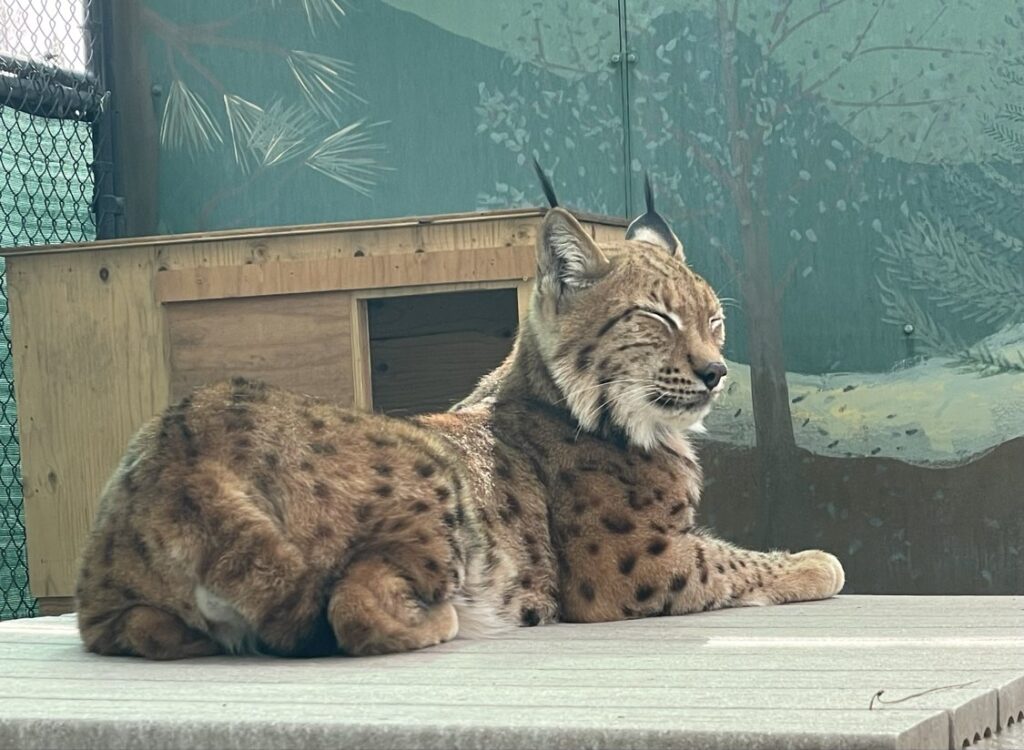Meet Taz, our Carpathian Lynx with a big personality and an important story. He’s a powerful reminder that wild animals belong in the wild, but he’s found a safe and caring home here with us.

Taz’s Journey to Cat Tales
Taz, our Carpathian Lynx, started his life in a very different environment. He was bought from a breeder and spent his first two years living inside a house as a pet. As he grew from a kitten into a 50-pound cat with sharp claws and teeth, his wild instincts started to show. Even a playful swipe became too dangerous for a home setting. His owner made the responsible decision to find him a place where he could receive the specialized care he needed. Now, Taz is thriving at Cat Tales in a secure habitat designed just for him, where he can climb, explore, and just be a lynx.
Why a Lynx Isn’t a Lap Cat
Taz’s story is a perfect example of why wild animals don’t make good pets. Even when raised by people, their natural instincts always remain.
All About Carpathian Lynx
Carpathian Lynx are one of the largest lynx subspecies, perfectly built for life in mountain forests.
- Big Paws: Their oversized, furry paws work like snowshoes, helping them walk on top of deep snow.
- Ear Tufts: Those long black hairs on their ears aren’t just for show—they act like antennas, helping them hear the quietest sounds.
- Facial Ruff: The “beard” of fur on their cheeks helps funnel sound to their ears.
- Spotted Coat: Their dense, soft fur is covered in spots, providing excellent camouflage in the forest.
These elusive cats are masters of stealth, preferring to live solitary lives deep in the forests of the Carpathian Mountains in Europe.
- Home Range: They live in dense forests with plenty of rocks and fallen trees to use as cover.
- Expert Hunters: Lynx are ambush predators, using their powerful hind legs to pounce on prey like deer and wild boar. They are most active at dawn and dusk.
- Family Life: A mother lynx will have a litter of 1-4 kittens, who stay with her for about 10 months to learn how to survive on their own.
Globally, lynx are listed as a species of “Least Concern,” but their populations face serious threats. The Carpathian Lynx population is one of the most stable in Europe, with about 2,800 individuals.
The biggest dangers they face are illegal hunting and habitat loss, as roads and development cut their forest homes into smaller pieces. Our conservation efforts focus on educating the public about these challenges to help protect wild populations.
A New Home for Taz at Cat Tales
Taz’s new home is still under construction, but it’s designed to meet all his needs! He has connected front and back spaces, so he can choose to be near visitors or retreat for some quiet time. We’ve added privacy tarps, climbing structures, and high platforms where he can survey his territory, just like he would in the wild. He lives outdoors year-round, which helps him grow the thick, beautiful winter coat his species is known for.
A bored lynx is an unhappy lynx! Our team works hard to keep Taz mentally stimulated. We hide his food around his habitat, encouraging him to use his powerful sense of smell to hunt for his dinner. Sometimes, wild birds fly into his space, giving him a chance to practice his natural stalking and pouncing skills. In the winter, he gets heated water bowls and warm bedding to stay cozy.
Our animal care staff are experts at reading Taz’s body language. They monitor him closely every day and keep detailed records of his behavior, diet, and overall health. This allows us to catch any potential issues early and ensure he is happy and thriving.
How Taz Helps His Wild Cousins
By providing a home for Taz, we can help protect lynx in the wild. As an animal ambassador, his story connects people to the bigger picture of conservation.
Education
Taz helps us teach thousands of visitors each year about the challenges lynx face in the wild and why it’s so important to protect their forest homes.
Advocacy
His story highlights the importance of laws like the Big Cat Public Safety Act, which protect wild animals from being sold into the pet trade.
Research
By observing Taz, we learn more about lynx behavior and welfare. This knowledge helps conservationists better understand what these amazing animals need to thrive, both here and in the wild.
